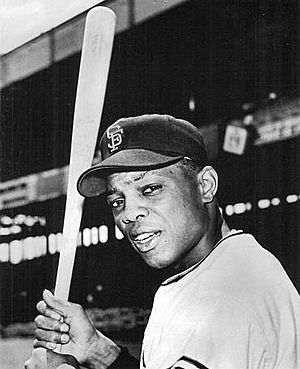African Americans in San Francisco facts for kids
African Americans have a rich history in San Francisco, California. Today, about 55,000 people of Black heritage live in the city. This community started during the California Gold Rush in the 1800s. Later, many Black families moved from the Southern United States. They found jobs working on railroads or in shipyards. The Fillmore District became a lively center for Black culture. It was even called the "Harlem of the West." This was like New York City's famous Harlem neighborhood.
Most Black residents in San Francisco live in areas like Bayview-Hunters Point and Visitacion Valley. San Francisco has a smaller percentage of Black residents compared to some other big U.S. cities. However, nearby Oakland has a much larger Black population. San Francisco has also had two Black mayors: Willie Brown and London Breed.
History of Black Communities in San Francisco
Early Days: Gold Rush to Great Migration
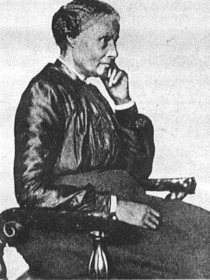
Important Black leaders were among the first settlers in California. One was William Alexander Leidesdorff, who helped start San Francisco.
During the California Gold Rush (1849-1855), many African Americans came to San Francisco. Some were enslaved people seeking freedom. Others were free people hoping for a better life. California became a free state in 1850, meaning slavery was not allowed. However, Black residents still faced unfair laws. They could not vote or speak against white people in court.
To fight these unfair rules, Black residents formed groups like the SF Executive Committee. They also created California's first Black newspaper, the Mirror of the Times, in 1857. Other newspapers followed, like the Pacific Appeal and the Elevator. By 1860, about 1,176 African Americans lived in San Francisco. This was 2% of the city's population. Many were middle class.
The first Black Baptist church west of the Rocky Mountains opened in San Francisco in 1852. It is now called the Third Baptist Church. Two African Methodist Episcopal Churches soon followed.
Despite job discrimination, Black residents in San Francisco owned a lot of property. By 1862, they owned $300,000 in assets. Much of this was real estate. Mary Ellen Pleasant, a successful businesswoman, owned a large part of this wealth.
After the Gold Rush, many Black men and women worked in service jobs. These included waiters, porters, and maids. Later, white labor unions made it harder for Black residents to find jobs. For example, in 1885, the Palace Hotel fired all its Black staff. They replaced them with white union workers.
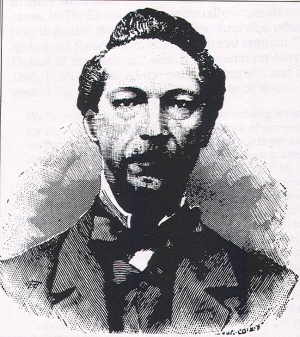
In the late 1800s and early 1900s, Black musicians and business owners helped create San Francisco's lively nightlife. This was especially true in the Barbary Coast area. Clubs like the So Different Club and Purcell's featured ragtime music. Famous musicians like Jelly Roll Morton also opened clubs.
Growth and Change: World War II to Today
During the Second Great Migration in the 1900s, many African Americans moved from the Southern United States. The San Francisco Bay Area was a popular place to go. San Francisco's Black population grew a lot during World War II. The government asked African Americans from the South to work at the Naval Docks in Hunters Point. Many moved to new housing built there.
By the end of World War II, the Fillmore District became the main center for Black life, music, and entertainment. It was known as the "Harlem of the West." The Black population in San Francisco grew from 4,836 in 1940 to 43,460 in 1950. This was a huge increase. Many Black families moved to the Fillmore District. This happened for three main reasons:
- The internment of Japanese Americans in 1942 left many empty homes and businesses in the Fillmore.
- World War II created many wartime jobs in shipbuilding.
- Many African Americans left the South to escape unfair Jim Crow laws.
After the war, Black residents greatly contributed to the growing jazz culture in the Fillmore. Clubs like Jimbo's Bop City became very popular. Famous musicians like Billie Holiday, Dizzy Gillespie, and Miles Davis performed there. The number of African Americans in the city kept growing. It reached its highest point of about 13% in the 1970s.
The Church for the Fellowship of All Peoples opened in 1948. It was the first church in the United States that welcomed people of all races and faiths.
The large number of African Americans moving to the city caused some racial tensions. Many Black residents were forced to live in certain neighborhoods. Businesses often refused to hire them. For example, in 1957, baseball star Willie Mays was denied the chance to buy a home in St. Francis Wood because of his race. In the 1960s, Black and white people protested against unfair hiring at many San Francisco businesses. The Civil Rights Movement helped make important legal changes for African Americans.
Since the 1970s, San Francisco's Black population has become smaller. This is due to several reasons. These include the high cost of living, urban renewal projects that tore down Black neighborhoods, and gentrification.
Community and Police Relations
The African American community in San Francisco has had a complex relationship with the San Francisco Police Department. Concerns about police brutality have been raised by many Black leaders and residents.
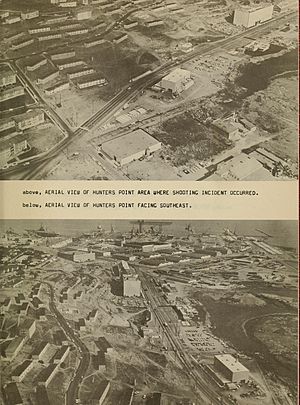
On September 27, 1966, a disturbance happened in the Hunters Point neighborhood. A 16-year-old Black boy, Matthew Johnson, was shot and killed by a white police officer. This led to four days of unrest. The National Guard was called in to help. The officer was later cleared of charges.
The Black Panther Party started in Oakland in 1966. They also had a presence in San Francisco. They worked to protect communities and suggested ideas for community policing.
In 1968, Black police officers formed the Officers for Justice association. This group later sued the San Francisco Police Department. They said the department was not hiring enough minority officers. Prentice Earl Sanders, a Black officer, later became the city's first Black police chief.
In the 1970s, a series of murders called the Zebra killings caused police to treat many Black men as suspects. This led to protests about racial profiling.
More recently, there have been protests about police shootings involving Black individuals. In 2015, Mario Woods, a 26-year-old African American man, was shot and killed by police. This led to many protests in the city. In 2020, a police officer was charged in an on-duty killing for the first time in San Francisco history. This was related to the death of Keita O'Neal in 2017.
Black Population in the Bay Area
The Black population in the Bay Area is mostly in San Francisco and the East Bay. Cities with a large Black population include North Richmond, Oakland, Richmond, and Vallejo. Other cities like Berkeley and East Palo Alto also have significant Black communities.
Politics and Leadership
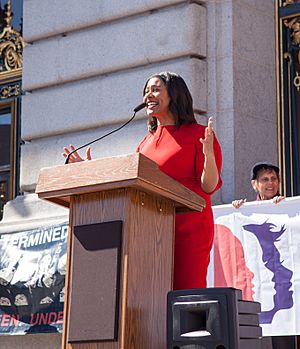
Black leaders have made important contributions to San Francisco's politics. In 1961, Cecile F Poole became the first African American to serve as a United States Attorney. He was also the first African American judge in Northern California. Terry Francois became the first African American on San Francisco's Board of Supervisors in 1964.
Willie Brown became the 41st Mayor of San Francisco in 1996. He was the first Black person to hold that office. He served two terms. After Mayor Ed Lee passed away, London Breed became acting mayor. She was officially sworn in as mayor in 2018. She is San Francisco's first female African-American mayor.
Culture and Arts

African Americans have greatly enriched San Francisco's culture. This includes music, literature, art, education, and theater.
Marcus Books, one of the country's first Black bookstores, opened in 1960. It was the oldest African American bookstore in the U.S.
The first Black Studies department in the United States was created at San Francisco State University in 1968. This happened after a student strike.
The St. John Coltrane African Orthodox Church, founded in 1971, still holds services in the Fillmore District.
The Lorraine Hansberry Theater, started in 1981, performs classic and new Black plays.
Radio station KPOO, which began in 1973, was the only Black-controlled independent public radio station west of the Mississippi. It was also the first to play rap music in 1979.
The San Francisco Black Film Festival started in 1998. It shares the work of filmmakers from the area and around the world. Movies like The Last Black Man in San Francisco have focused on San Francisco's Black community.
The Museum of the African Diaspora opened in 2005. It shows the history, art, and culture of people of African descent worldwide.
The African American Art and Culture Complex on Fulton Street hosts many events. It is home to several Black arts organizations. These include the African American Historical and Cultural Society and the African-American Shakespeare Company.
Notable People
Business Leaders
- Mary Ellen Pleasant, businesswoman and abolitionist
- William Alexander Leidesdorff, businessman and city treasurer
- George Washington Dennis, 19th century businessman
- William T. Shorey, whaling captain
- Charles Sullivan, music promoter
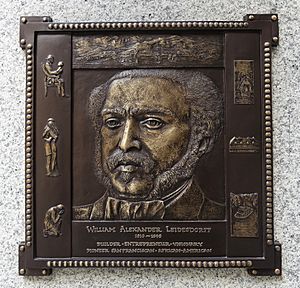
Political Figures
- Howard Thurman, civil rights leader
- Prentice Earl Sanders, first Black police chief
- Terry Francois, first African American on the San Francisco Board of Supervisors
- Ella Hill Hutch, city supervisor
- Willie Brown (politician), 41st Mayor of San Francisco
- London Breed, current Mayor of San Francisco
Activists
- Charlotte L. Brown, challenged 19th century streetcar segregation
- Elouise Westbrook, community activist
- Sarah Webster Fabio, poet, educator, and activist
- Christopher Muhammad, Bay Area Minister
- Hettie B. Tilghman, church organizer
- Bob Slattery, civil rights leader
- Cecil Williams, pastor at Glide Memorial Church
Film and Entertainment
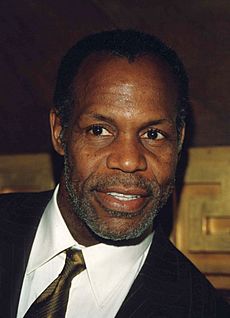
- Jimmie Fails, actor known for The Last Black Man in San Francisco
- Danny Glover, successful Hollywood actor
- Terri J. Vaughn, actress
- Kevin Epps, filmmaker
Writers
- Maya Angelou, writer
- bob Kaufman, Beat Generation poet
- Devorah Major, Poet Laureate of San Francisco
Musicians
- Johnny Mathis, singer
- RBL Posse, rap group
- 11/5, rap group
- Cindy Herron, singer and founding member of En Vogue
- Martin Luther McCoy, actor, guitarist, and musician
- Larry June, rapper
- Prezi, rapper
- Etta James, singer
- Sylvester, singer
Medical Professionals
- William Byron Rumford, pharmacist and politician
Journalists
- Philip Alexander Bell, 19th century newspaper editor
- Carlton Benjamin Goodlett, newspaper owner
- Thomas C. Fleming, newspaper reporter
Sports Figures
- Willie Mays, legendary baseball player for the San Francisco Giants
- John Nisby, football player
- O. J. Simpson, football player
- Desmond Bishop, professional NFL player
- Stevie Johnson, NFL wide receiver
- Eric Wright, NFL player
- Donald Strickland, NFL player
- T. J. Ward, NFL player
- Karim Mayfield, professional boxing champion
Artists
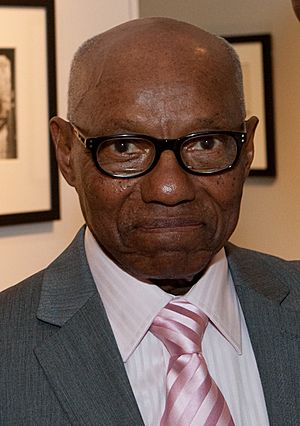
- Sargent Johnson, artist known for painting, drawing, and sculpting
- David Johnson, photographer known for jazz culture and civil rights movement photos
See Also
- Demographics of San Francisco





